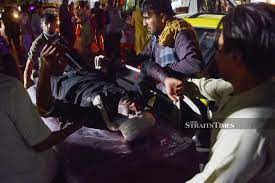
KABUL, Aug 26, 2021 (BSS/AFP) - Two explosions rocked Kabul airport
Thursday, killing at least six people and injuring a dozen others
after Western nations warned of an imminent terror threat and as
thousands of people gathered hoping for a flight out of
Taliban-controlled Afghanistan.
The blasts came as the August 31 deadline loomed for the United
States to withdraw its troops, and for Western countries to end their
massive airlifts.
The "complex attack" near the airport caused a number of US and
civilian casualties, Pentagon spokesman John Kirby said in a tweet.
According to the city's main Emergency Hospital, at least six
people were killed and more than a dozen injured in the blasts.
US President Joe Biden had earlier cited an "acute" terrorist
threat from the regional chapter of the Islamic State jihadist group.
An AFP journalist in Kabul saw a plume of smoke rising into the sky
from a site near the airport.
"When people heard the explosion there was total panic. The Taliban
then started firing in the air to disperse the crowd at the gate," a
witness told AFP on condition of anonymity.
"I saw a man rushing with an injured baby in his hands," he added.
The US government and its allies had raised the alarm earlier in
the day with a series of advisories warning their citizens to avoid
the airport.
No specifics were given in the terror advisories, but Belgium's
Prime Minister Alexander De Croo referred to a threat from suicide
bombers.
London also issued a warning to its citizens, saying "if you can
leave Afghanistan safely by other means, you should do so
immediately".
- 'Truly heartbreaking' -
Images posted on social media, which could not be immediately
verified, showed men ferrying injured people to safety in
wheelbarrows.
In another picture a boy was seen clutching the arm of a man whose
clothes were soaked in blood.
More than 95,000 Afghans and foreigners have fled Afghanistan via
the US-led airlift since the hardline Taliban movement took control of
the country on August 15.
Despite the US and other warnings of a looming terror threat, huge
crowds of people desperate to flee the Taliban continued to throng the
airport, their bid for a way out becoming increasingly anxious ahead
of the August 31 deadline set by Biden to end evacuations and withdraw
troops.
Biden and his aides have not budged on the hard deadline -- even as
some foreign nations warned they would be forced to leave at-risk
Afghans behind.
The Pentagon had earlier Thursday reiterated that operations would
continue until the cut-off.
But several Western allies have already wrapped up their airlift
operations including Canada, whose government said it was "truly
heartbreaking" to leave behind those who wanted to be rescued.
- Islamic State threat -
In recent years, the Islamic State's Afghanistan-Pakistan chapter
has been responsible for some of the deadliest attacks in those
countries.
It has massacred civilians at mosques, shrines, public squares and
even hospitals.
The group has especially targeted Muslims from sects it considers
heretical, including Shiites.
But while IS and the Taliban are both hardline Sunni Islamist
militants, they are rivals and oppose each other.
The Taliban have promised a softer brand of rule from their first
stint in power, which ended in 2001 when the United States invaded
because they gave sanctuary to Al-Qaeda.
But many Afghans fear a repeat of the Taliban's brutal
interpretation of sharia law, as well as violent retribution for
working with foreign militaries, Western missions or the previous
US-backed government.
There are particular concerns for women, who were largely banned
from education and employment and could only leave the house with a
male chaperone during the group's 1996-2001 rule.
- 'Red line' -
Some of the Afghans massed outside the airport have foreign
passports, visas or eligibility to travel, but most do not.
Several people have died in the chaos around the airport in recent days.
Despite the harrowing scenes, the Taliban have ruled out any
extension to next Tuesday's deadline to pull out foreign troops,
describing it as "a red line".